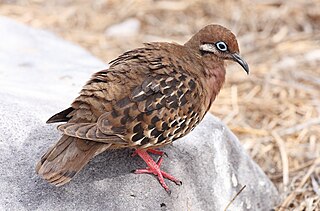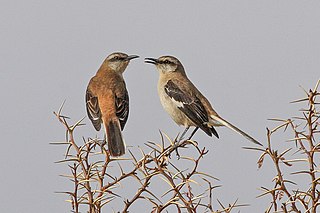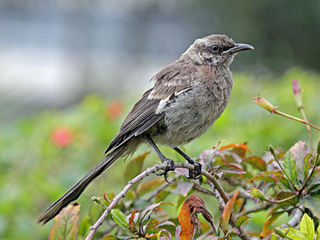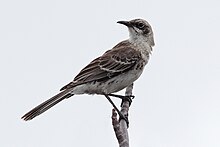
Mockingbirds are a group of New World passerine birds from the family Mimidae. They are best known for the habit of some species mimicking the songs of other birds and the sounds of insects and amphibians, often loudly and in rapid succession. There are about 17 species in two genera, although three species of mockingbird from the Galapagos Islands were formerly separated into a third genus, Nesomimus. The mockingbirds do not appear to form a monophyletic lineage, as Mimus and Melanotis are not each other's closest relatives; instead, Melanotis appears to be more closely related to the catbirds, while the closest living relatives of Mimus appear to be thrashers, such as the sage thrasher.

The two-banded puffbird is a species of near-passerine bird in the family Bucconidae, the puffbirds, nunlets, and nunbirds. It is found in Colombia and Venezuela.

The tropical mockingbird is a resident breeding bird from southern Mexico to northern and eastern South America and in the Lesser Antilles and other Caribbean islands.

The chalk-browed mockingbird is a bird in the family mimidae. It is found in Brazil, Bolivia, Argentina, Paraguay, Suriname, and Uruguay.

The festive coquette is a species of hummingbird in the "brilliants", tribe Lesbiini of subfamily Lesbiinae. It is endemic to Brazil.

The semicollared puffbird is a species of near-passerine bird in the family Bucconidae, the puffbirds, nunlets, and nunbirds. It is one of seven species of the genus Malacoptila. It is found in Bolivia, Brazil, and Peru.

The Andean potoo is a species of bird in the family Nyctibiidae. It is found in Bolivia, Colombia, Ecuador, Peru, and Venezuela.

The Galápagos dove is a species of bird in the family Columbidae. It is endemic to the Galápagos, off Ecuador. It is fairly common and is found in a wide range of open and semi-open habitats, especially in the arid lowlands of the archipelago.

The scaly-breasted thrasher is a species of bird in the family Mimidae. It is found throughout much of the Lesser Antilles of the Caribbean Sea.

The brown-backed mockingbird is a species of bird in the family Mimidae. It is found in Argentina and Bolivia.

Mimus is a bird genus in the family Mimidae. It contains the typical mockingbirds. In 2007, the genus Nesomimus was merged into Mimus by the American Ornithologists' Union. The genus name is Latin for "mimic".

The Bahama mockingbird is a species of bird in the family Mimidae. It is found in the Bahamas, Cuba, Jamaica and the Turks and Caicos Islands, and is a vagrant to Florida.

The long-tailed mockingbird is a species of bird in the family Mimidae. It is found in Ecuador and Peru.

The Patagonian mockingbird is a species of bird in the family Mimidae. It is found in much of Argentina and locally in Chile.

The Chilean mockingbird, locally known as tenca, is a species of bird in the family Mimidae. It primarily inhabits Chile's northern half, though there are sightings in Argentina.

The white-banded mockingbird is a species of bird in the family Mimidae. It is found in Argentina, Bolivia, Brazil, Chile, Paraguay, and Uruguay.

The Hood mockingbird, also known as the Española mockingbird, is a species of bird in the family Mimidae. It is endemic to Española Island in the Galápagos Islands, Ecuador, and it is one of four closely related mockingbird species endemic to the Galápagos archipelago. It is found in dry forests and is omnivorous, though it primarily is a carnivore or scavenger. The species has a highly territorial social structure and has no fear of humans. It is the only species of Galápagos mockingbird that Charles Darwin did not see or collect on the voyage of the Beagle.

The Galápagos mockingbird is a species of bird in the family Mimidae. It is endemic to the Galápagos Islands, Ecuador.

The Floreana mockingbird or the Charles Island mockingbird, is a species of bird in the family Mimidae. It was endemic to Floreana, one of the Galápagos Islands, but now is found only on two nearby islets, Campeón and Gardner-near-Floreana. The Floreana mockingbird is also known as Darwin's mockingbird, as it was the arguable inspiration for Charles Darwin's work on the origins of species; he noticed distinct differences between them and previous species he had encountered and consequently established the existence of other variants on neighboring islands.






















